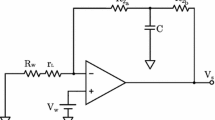Summary
Usually a Coriolis mass flowmeter consists of a fluid conveying vibrating pipe segment with a reflection symmetry, on which the time delay Δτ is measured between the vibrations of two symmetrically situated cross sections. For a homogeneous pipe segment, the proportionality factorK c between Δτ and the mass flowrate\(\dot Q_m\), i.e. the calibration factor of the instrument, is independent of the nature of the flowing fluid. Fixing a concentrated massm c at the middle of the pipe segment — as required e.g. for the purpose of a symmetric excitation of the vibration — brings about a dependence of the factorK c on the fluid density. In the present paper the influence of the massm c on the vibration spectrum and on flowmetering is investigated in detail for an instrument working with a straight pipe segment. It turns out that, whereas the frequency of the fundamental vibration mode is strongly influenced bym c , the calibration factorK c is practically independent of the massm c , up to fairly high values compared to the mass of the fluid filled pipe segment.
Übersicht
Ein Coriolis-Durchflußmeßgerät ist üblicherweise ein von einem Fluid durchströmter schwingender Rohrabschnitt, der eine Spiegelungssymmetrie besitzt und an dem der Zeitunterschied Δτ zwischen den Schwingungen zweier symmetrisch gelegener Querschnitte gemessen wird. Für einen homogenen Rohrabschnitt ist der ProportionalitätsfaktorK C zwischen Δτ und dem Massenstrom\(\dot Q_M\), d. h. der Kalibrierungsfaktor des Instrumentes, unabhängig von der Natur des Fluids. Das Anbringen einer konzentrierten Massem c an der Mitte des Rohrabschnittes — etwa zum Zwecke einer symmetrischen Anregung der Schwingung — hat eine Abhängigkeit des FaktorsK C von der Fluiddichte zur Folge. In der vorliegenden Arbeit wird der Einfluß der Massem c auf das Schwingungsspektrum und die Durchflußmessung bei einem Instrument mit geradem Rohrabschnitt eingehend untersucht. Es ergibt sich, daß die Schwingungsfrequenz der Grundmode zwar stark vonm c beeinflußt wird, der KalibrierungsfaktorK C aber praktisch unabhängig vonm c ist, bis zu ziemlich hohen Werten vonm c verglichen mit der Masse des gefüllten Rohrabschnittes.
Similar content being viewed by others
References
Raszillier, H.;Durst, E.: Coriolis effect in mass flow metering. Arch. Appl. Mech. 61 (1991) 192–214
Sultan, G.;Hemp, I.: Modelling of the Corolis mass flowmeter. J. Sound and Vibration 132 (1989) 473–489
Raszillier, H.;Raszillier, V.: Dimensional and symmetry analysis of Corriolis mass flowmeters. Flow Meas. Instr. 2 (1991) 180–184
Sultan, G.: Single straight-tube Coriolis mass flowmeter. Flow Meas. Instr. 3 (1992) 241–246
Raszillier, H.;Alleborn, N.;Durst, F.: Mode mixing in Coriolis flowmeters. Arch. Applied Mechanics 63 (1993) 219–227
Author information
Authors and Affiliations
Rights and permissions
About this article
Cite this article
Raszillier, H., Alleborn, N. & Durst, F. Effect of a concentrated mass on coriolis flowmetering. Arch. Appl. Mech. 64, 373–382 (1994). https://doi.org/10.1007/BF00788409
Received:
Issue Date:
DOI: https://doi.org/10.1007/BF00788409




